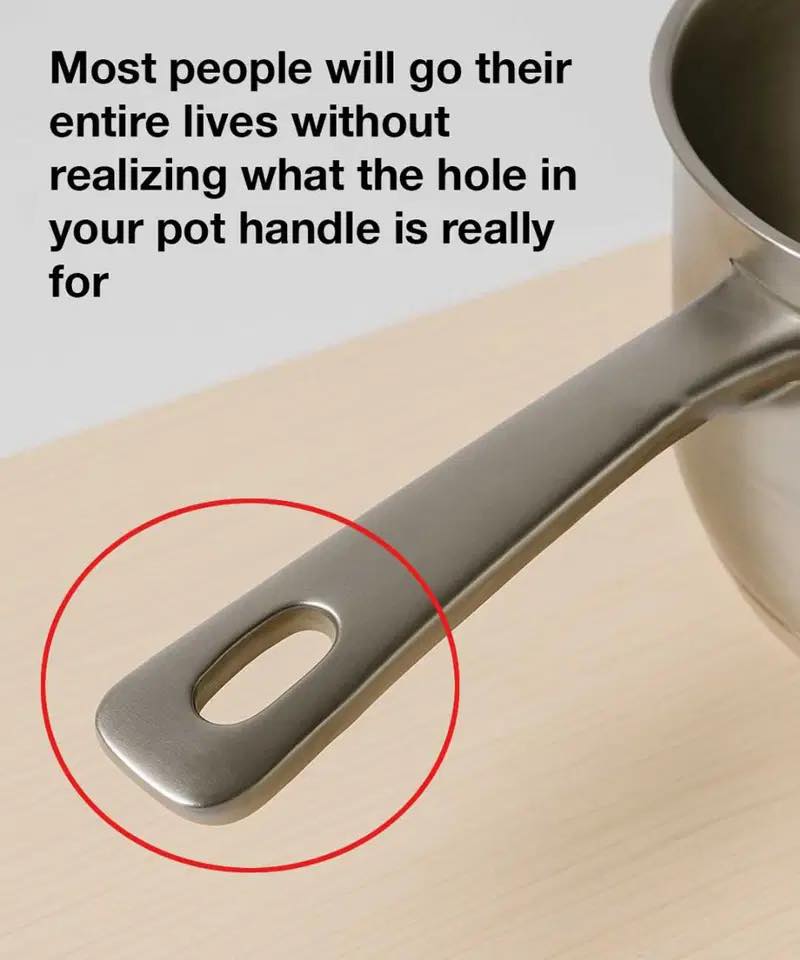In the world of kitchen tools and cookware, every design detail tends to have a specific purpose, even if it’s not obvious at first glance. One of those often-overlooked features is the small hole in the handle of pots and pans. Most of us have probably never given it much thought, assuming it’s just there for hanging or maybe even part of the manufacturing process.

But that little hole is actually a surprisingly smart and versatile feature with multiple uses that can make cooking easier, cleaner, and more efficient. While many people might go their entire lives without realizing its full potential, once you know what it can do, you may never look at your cookware the same way again. For starters, the most common assumption is that the hole is simply for hanging the pot on a hook. And yes, that’s definitely part of its purpose. If you have limited cabinet space or just want a more accessible and organized setup, using the hole to hang your cookware on a rack or wall hook can free up room and help you find what you need more quickly. It also prevents pots from being stacked on top of one another, which can cause scratches and dents over time. But beyond storage, that little hole is much more functional than it appears.
One of the most clever uses of the pot handle hole is as a spoon rest. Instead of placing your sauce-covered spoon on the counter or scrambling to find a spoon rest, you can slip the handle of the spoon through the hole, allowing the spoon to hang neatly above the pot. This keeps drips contained, your countertops cleaner, and your utensils right where you need them. It’s one of those simple tricks that make you wonder how you ever lived without it. Another surprisingly useful application is for pouring.
When you’re transferring hot soup, sauce, or stock from a pot into another container, it’s not always easy to control the flow. If you insert a wooden spoon or similar utensil through the hole, it can act as a guide to create a more precise pouring spout, helping you avoid splashes and spills. It’s a small adjustment that can make a big difference, especially when dealing with hot liquids or trying to pour into a narrow opening. For those who cook more casually and aren’t always reaching for measuring cups, the hole can also serve as a rough measuring guide. While it’s not precise, it can give you a decent visual estimate for dry ingredients like rice or pasta.
Say you’re boiling pasta and don’t want to overdo it—some cooks use the diameter of the hole as a way to measure out a single serving of spaghetti. It’s not going to replace your measuring tools, but it can come in handy when you just need a quick visual cue. Additionally, the hole can provide extra grip and leverage when handling the pot. If you’re using a towel or oven mitt and worried about dropping a heavy, hot pan, slipping a finger or thumb through the hole gives you extra stability and control. It’s particularly useful when lifting a pot full of liquid or when you need to stir and keep the pot steady at the same time.
It’s one of those details you probably never noticed before, but once you use it for this purpose, you’ll find yourself doing it often. So while it may look like a simple little hole with no real importance, the pot handle hole is actually a multi-purpose feature that offers real benefits in the kitchen. Whether it’s helping you stay tidy while cooking, giving you a better grip, offering a makeshift measuring trick, or making pouring more controlled, it’s a testament to the smart design behind everyday objects. The next time you’re using a pot or pan, take a moment to appreciate that tiny detail—it’s doing more work than you probably ever realized.





